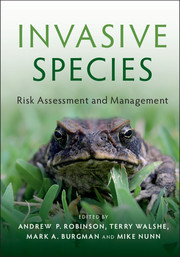Book contents
- Invasive Species
- Invasive Species
- Copyright page
- Contents
- Contributors
- Foreword
- 1 The Allocation of Inspection Resources
- 2 Tools for Designing and Evaluating Post-Border Surveillance Systems
- 3 Control Charts for Biosecurity Monitoring and Surveillance
- 4 Open-Source Intelligence Gathering and Open-Analysis Intelligence for Biosecurity
- 5 Predicting Distributions of Invasive Species
- 6 Mapping Risks and Impacts of Invasive Alien Species with Dynamic Simulation Models
- 7 Models for Understanding Disease Dynamics
- 8 Bayesian Networks for Import Risk Assessment
- 9 Getting the Message Right: Tools for Improving Biosecurity Risk Communication
- 10 Cost–Benefit Analysis for Biosecurity Decisions
- 11 Valuing Protection against Invasive Species Using Contingent Valuation
- 12 Management of Invasive Species: Info-Gap Perspectives
- 13 Decisions with Relative Robustness
- 14 Optimising Resource Allocation
- 15 Value of Information Analysis as a Decision Support Tool for Biosecurity
- 16 Declaring Eradication of an Invasive Species
- 17 Surveillance for Detection of Pests and Diseases: How Sure Can We Be of Their Absence?
- 18 Some Questions to Ask Yourself
- Index
- References
Foreword
Towards Evidence-Based and Risk-Weighted Strategies for Biosecurity
Published online by Cambridge University Press: 03 July 2017
- Invasive Species
- Invasive Species
- Copyright page
- Contents
- Contributors
- Foreword
- 1 The Allocation of Inspection Resources
- 2 Tools for Designing and Evaluating Post-Border Surveillance Systems
- 3 Control Charts for Biosecurity Monitoring and Surveillance
- 4 Open-Source Intelligence Gathering and Open-Analysis Intelligence for Biosecurity
- 5 Predicting Distributions of Invasive Species
- 6 Mapping Risks and Impacts of Invasive Alien Species with Dynamic Simulation Models
- 7 Models for Understanding Disease Dynamics
- 8 Bayesian Networks for Import Risk Assessment
- 9 Getting the Message Right: Tools for Improving Biosecurity Risk Communication
- 10 Cost–Benefit Analysis for Biosecurity Decisions
- 11 Valuing Protection against Invasive Species Using Contingent Valuation
- 12 Management of Invasive Species: Info-Gap Perspectives
- 13 Decisions with Relative Robustness
- 14 Optimising Resource Allocation
- 15 Value of Information Analysis as a Decision Support Tool for Biosecurity
- 16 Declaring Eradication of an Invasive Species
- 17 Surveillance for Detection of Pests and Diseases: How Sure Can We Be of Their Absence?
- 18 Some Questions to Ask Yourself
- Index
- References
- Type
- Chapter
- Information
- Invasive SpeciesRisk Assessment and Management, pp. xi - xivPublisher: Cambridge University PressPrint publication year: 2017



